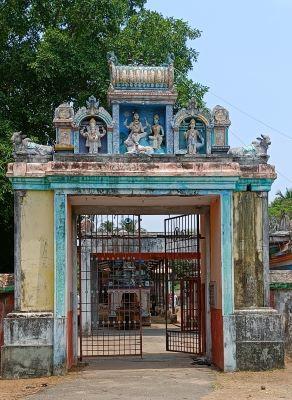Origin/History :-
The Narthanapureeswarar Temple has its origins dating back to before the 7th century, as Thirunavukkarasu Swamigal sang hymns in praise of Lord Shiva here. This indicates the existence of the original temple during that time. The temple was later reconstructed as a stone temple during the Chozha period and was further extended during the Nayakas and Marathas periods.
Inscriptions from the Rajaraja II and Nayaka periods have been found in the temple. As per the inscriptions, this place was called Kulothunga Chozha Valanattu Inganattu Thalayalangadu, and Lord Shiva was referred to as Thalayalangadudayar. An inscription from the 7th reign year of Rajaraja II (6+1) records a land donation of 9 ma by Arayan Sivathakana Nayagan alias Kalingarayan, establishing the endowment of the "Sivathakana Nayakan Sandhi" pooja for Adhi Chandikeswarar. His son also signed the donation agreement. A separate 9th reign inscription confirms this endowment.
A Saka 1568 (1646 CE) inscription, without a king's name, mentions the construction of the maha mandapam by Sendalangara Udayar, listing his grandfather as Pukaludaithambarnathar and his father as Arumai Udayar. Additionally, a 17th-century inscription records services rendered to the temple by Azhakiya Chidambaranatha Udayar and Ariyanayinar.
The most recent Maha Kumbabishekam (grand consecration ceremony) took place in 2013, and the temple is associated with the "Enkan" Murugan temple network.
Puranic Significance :-
The legend of the Narthanapureeswarar Temple revolves around a group of arrogant sages from Dharukavanam. In their vanity, the sages believed that their penance was superior to that of the gods. To teach them a lesson, Lord Shiva instructed Mahavishnu to take the form of Mohini, a beautiful enchantress, to distract the sages from their penance. As expected, the sages succumbed to Mohini’s charm, failing in their penance.
Simultaneously, Lord Shiva took the form of Pichandavar, a wandering mendicant, and approached the sages’ houses for alms. The wives of the sages, known for their piety, were captivated by Pitchandavar and began following him, shattering the sages' belief in their wives' devotion and faithfulness.
Angered and humiliated, the sages realised that this was a divine play by Lord Shiva. In retaliation, they performed a Yagna (Abhichara Velvi) and summoned evil spirits and weapons, including an elephant, a tiger, and a demon named Muyalakan, to kill Lord Shiva. However, Lord Shiva effortlessly subdued all the weapons, vanquished the elephant and tiger, and wore their skins as his attire. He then danced upon the body of the demon Muyalakan.
Realising their mistake, the sages repented and surrendered to Lord Shiva. Since Lord Shiva is believed to have performed his dance upon the demon’s body at this location, he is venerated here as Sri Narthanapureeswarar (where “Narthanam” means dance in Tamil).
